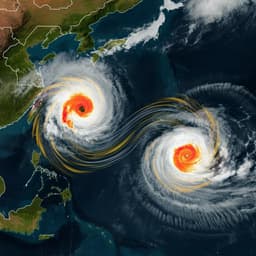
Earth Sciences
The mean state of the tropical Pacific Ocean differed between the Medieval Warm Period and the Industrial Era
S. Jiang, X. Zhou, et al.
Explore the fascinating changes in the El Niño Southern Oscillation (ENSO) over the past 1800 years, revealing how climate periods influenced its mean state and variance. This groundbreaking research by Shiwei Jiang, Xin Zhou, Julian P. Sachs, Zhibo Li, Luyao Tu, Yiyi Lin, Xuanqiao Liu, Anze Chen, and Yanan Shen sheds light on the anthropogenic impacts driving these variations in the tropical Pacific.
~3 min • Beginner • English
Introduction
The El Niño–Southern Oscillation (ENSO) exerts global climate impacts via coupled sea surface temperature (SST) and atmospheric pressure anomalies across the tropical Pacific. Instrumental observations span only ~150 years, limiting detection of long-term changes in the tropical Pacific mean state and its relationship with ENSO variance. Prior reconstructions and model results disagree on whether the Medieval Warm Period (MWP) and Little Ice Age (LIA) featured La Niña-like or El Niño-like mean states, with hydroclimate-based indices potentially confounded by meridional shifts of the Intertropical Convergence Zone (ITCZ). East Asia, particularly regions outside the direct ITCZ influence, exhibits robust teleconnections to tropical Pacific SST patterns through the Western Pacific Subtropical High (WPSH), with a dipole/tripole precipitation pattern between the Jiang-Huai (JH) and North China (NC) regions linked to ENSO-like mean-state changes. This study reconstructs an 1800-year index of the tropical Pacific mean state using two high-resolution East Asian lake-sediment precipitation records, evaluates centennial-scale mean-state and variance changes across the Common Era, and assesses likely forcings by comparing the index to reconstructions of global/northern hemisphere temperatures and radiative forcing.
Literature Review
- Instrumental data are too short to resolve centennial mean-state changes; thus paleoclimate and modeling studies are used. SST proxies and coral/foraminiferal oxygen isotopes across the tropical Pacific have often suggested La Niña-like conditions during the MWP (~1000–1300 CE) and El Niño-like conditions during the LIA (~1400–1850 CE). In contrast, hydrology-based Southern Oscillation Index (SOI) reconstructions inferred El Niño-like MWP and La Niña-like LIA. Models likewise show contradictory responses. Hydrological changes in the equatorial Pacific can reflect both ENSO-related zonal changes and ITCZ meridional shifts, complicating interpretation of hydroclimate as a strict mean-state indicator. - East Asian precipitation exhibits a coherent tripole pattern tied to tropical Pacific SST anomalies through atmospheric teleconnections involving the WPSH. Observations, paleo-records, and models show opposite precipitation changes in JH vs NC regions under El Niño-like vs La Niña-like states. Past studies also document regional hydroclimatic anomalies during MWP/LIA and distinct warm-dry/cool-wet and warm-wet/cool-dry relationships across East Asia on centennial to millennial scales. These factors motivate using East Asian precipitation reconstructions as a proxy for tropical Pacific mean-state changes less affected by ITCZ migration.
Methodology
- Data selection and spatial classification: Compiled 20 East Asian paleo-precipitation records (outside the direct ITCZ influence), each with sufficient chronology to identify MWP/LIA, average resolution <70 years, and established precipitation proxies. Classified each site’s MWP/LIA hydroclimate (dry/moderately dry/moderately wet/wet) by comparing interpolated values within each period against the site’s median over the past millennium (thresholds at 1/2 and 2/3 of observations). - Mean-state index reconstruction: Chose two high-resolution records with excellent age control to construct a tropical Pacific mean-state index: Lake Nvshan (JH region) sediment redness (a*/L*; proxy for precipitation via lake level and redox conditions), mean resolution 1.4 years; Lake Gonghai (NC region) pollen-based annual precipitation, mean resolution 5.6 years. Interpolated both to 5-year steps (Acycle 2.4.1), normalized to Z-scores, and defined the index as ZJH − ZNC. By construction, negative index values indicate La Niña-like mean states; positive values indicate El Niño-like. - Uncertainty estimation: Built Bayesian age models (BACON in R) using AMS 14C dates (5 for Nvshan; 8 for Gonghai) on terrestrial plant macrofossils. Accounted for analytical uncertainties (Nvshan redness ±0.5–1%; Gonghai precipitation ±88 mm/yr). Applied Monte Carlo simulations (1000 iterations) propagating dating and proxy uncertainties by time-shifting within dating errors, recalculating Z-scores and index to obtain a time-varying standard deviation as confidence bounds. - Statistical analysis: Used Pearson correlations with effective degrees of freedom to assess relationships between the index and independent reconstructions (zonal SST gradients, coral and speleothem δ18O, temperatures, radiative forcing). - Variability analysis: High-pass filtered the index using a 50-year Lanczos filter, then computed a 100-year running biweight variance to assess centennial-scale variability. Compared variance to other ENSO variance proxies: North American Drought Atlas, Palmyra coral δ18O standard deviation (50-year sliding window), and foraminiferal δ18O variance from an EEP sediment core. Conducted spectral and wavelet analyses to identify periodicity shifts.
Key Findings
- Mean-state reconstruction over 1800 years reveals four centennial-scale phases: La Niña-like (negative Z) at 250–850 CE and 1050–1300 CE; El Niño-like (positive Z) at 950–1050 CE and 1400–1950 CE. The MWP was La Niña-like; the LIA was El Niño-like. - Strong agreement with independent SST-based reconstructions: correlation with the tropical Pacific zonal SST gradient (Indo-Pacific Warm Pool and EEP combined) r = −0.76, p < 0.01; with composite stalagmite δ18O Z-scores from the Asian-Australian monsoon region r = 0.42, p < 0.05; consistent with central tropical North Pacific coral δ18O and equatorial zonal SST gradient reconstructions. - The index differs from an SOI reconstruction based on tropical Pacific hydroclimate, likely due to ITCZ influences on equatorial precipitation proxies, suggesting SST-pattern-based indicators are more reliable for mean-state inference in this context. - Forcings and temperatures (pre-industrial, 1000–1850 CE): index correlates with global mean temperature (GMT) r = −0.75, p < 0.01; Northern Hemisphere temperature r = −0.59, p < 0.01; effective radiative forcing (solar + volcanic) r = −0.52, p < 0.05; total solar irradiance r = −0.61, p < 0.01. Higher radiative forcing/warmer GMT align with La Niña-like states (e.g., MWP); lower forcing/cooler GMT align with El Niño-like states (e.g., LIA). - Industrial/Current Warm Period (CWP): Despite rising GMT, the index and zonal SST gradient indicate more El Niño-like mean states, consistent with greenhouse-gas-driven weakening of the Pacific Walker circulation in several GCMs. - Variability: Centennial-scale variance was lowest during the MWP (~0.25), increased after ~1400 CE, peaked near ~1650 CE (~1.0), and remained high into the CWP. Variance was generally higher during the LIA and CWP than during the MWP. Periodicity shifted from ~250-year cycles (MWP) to ~130-year cycles (LIA). Variance changes agree with other proxies: strong correlation with North American Drought Atlas (r = 0.78, p < 0.05); moderate correlation with EEP foraminiferal δ18O variance (r = 0.47, p = 0.058); consistent with Palmyra coral δ18O standard deviation. Overall, El Niño-like mean states co-occur with higher variability; La Niña-like mean states with reduced variability.
Discussion
The East Asian precipitation-based index robustly tracks centennial-scale changes in the tropical Pacific mean state, in agreement with SST-derived indicators and extra-equatorial proxies, thereby reconciling conflicts with hydroclimate-based SOI reconstructions that can be contaminated by ITCZ shifts. The MWP’s La Niña-like mean state and the LIA’s El Niño-like mean state during the pre-industrial era are consistent with the ocean dynamical thermostat mechanism: enhanced effective radiative forcing preferentially warms the western equatorial Pacific, steepens the zonal SST gradient, strengthens the Walker circulation, and promotes La Niña-like conditions; reduced forcing yields the opposite. In contrast, during the industrial period rising greenhouse gases are associated with weakening Walker circulation, reduced zonal SST gradient, and El Niño-like mean states, aligning with several GCM projections of greenhouse-gas-induced atmospheric circulation changes. The observed coupling between mean state and variability supports a positive feedback in which El Niño-like mean conditions amplify ENSO variance, and heightened variance can further project onto an El Niño-like mean state. These findings imply that anthropogenic greenhouse forcing may favor a more El Niño-like tropical Pacific in the future, with implications for global hydroclimate teleconnections.
Conclusion
An 1800-year reconstruction of the tropical Pacific mean state from East Asian lake-sediment precipitation records shows a La Niña-like, low-variance MWP, and El Niño-like, higher-variance LIA and industrial/CWP. The study demonstrates differing responses of the tropical Pacific mean state to radiative forcing sources: pre-industrial changes linked to effective solar/volcanic forcing (consistent with the ocean dynamical thermostat), versus industrial-era changes dominated by greenhouse gas forcing that favor El Niño-like conditions. The work helps reconcile discrepancies among proxy reconstructions by highlighting ITCZ influences on equatorial hydroclimate indicators and supports the use of extratropical teleconnected hydroclimate records to infer mean-state changes. Future research should develop additional high-resolution records from multiple ENSO-teleconnected regions to refine constraints on forcing mechanisms, mean-state–variance coupling, and model validation for future projections.
Limitations
- Potential teleconnection non-stationarity: ENSO type (central vs eastern Pacific) and extratropical influences could modulate the East Asia–tropical Pacific linkage. - Proxy and chronology uncertainties: Although addressed via BACON age modeling and Monte Carlo simulations, dating and analytical errors remain. - Spatial representativeness: The mean-state index relies mainly on two sites (Lake Nvshan and Lake Gonghai), which, while high-resolution, may not capture the full spatial complexity of East Asian precipitation responses. - Confounding factors in comparative datasets: Equatorial hydroclimate proxies used in other studies can be affected by ITCZ migration, complicating cross-proxy comparisons; some reference records show internal inconsistencies. - Model divergence: Climate models differ on the sign of mean-state response to radiative forcing and greenhouse gases, introducing uncertainty in mechanistic interpretation and future projections.
Related Publications
Explore these studies to deepen your understanding of the subject.







